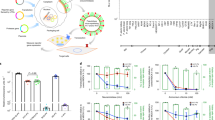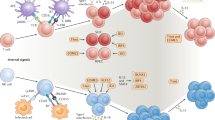Abstract
MALIGNANT cell transformation is often accompanied by the appearance of new cell-surface antigens1–3 of four classifications (defined in ref. 3): (1) embryonic antigens (EA) that are also present on normal embryonic cells; (2) differentiation antigens (DA) so called because they are also expressed on certain normal syngeneic or allogeneic cells; (3) virus structural antigens (VSA) inserted in the surface membrane of infected cells which may or may not be transformed, and (4) tumour-specific transplantation antigens (TSTA), antigens associated with tumour rejection.
This is a preview of subscription content, access via your institution
Access options
Subscribe to this journal
Receive 51 print issues and online access
$199.00 per year
only $3.90 per issue
Buy this article
- Purchase on Springer Link
- Instant access to full article PDF
Prices may be subject to local taxes which are calculated during checkout
Similar content being viewed by others
References
Klein, G., A. Rev. Microbiol., 20, 223–252 (1966).
Bauer, H., Adv. Cancer Res., 20, 275–341 (1974).
Kurth, R., in Surfaces of Normal and Transformed Cells (edit. by Hynes, R. O.), (Wiley, London, 1976).
Kurth, R., and Bauer, H., BBA Reviews on Cancer, 417, 1–23 (1975).
Meyers, P., Sigel, M. M., and Holden, H. T., J. natn. Cancer Inst., 49, 173–181 (1972).
Kurth, R., and Bauer, H., Virology, 47, 426–433 (1972).
Morris, R. E., and Fritz, R. B., Cancer Res., 36, 414–419 (1976).
Kurth, R., J. gen. Virol, 28, 167–177 (1975).
Kurth, R., Wyke, J. A., Friis, R. R., Rohrschneider, L., and Bauer, H., J. supramolec. Struct., 4, 133–139 (1976).
Vogt, P. K., and Ishizaki, R., Virology, 30, 368–374 (1966).
Friis, R. R., Toyoshima, K., and Vogt, P. K., Virology, 43, 375–389 (1971).
Hatanaka, M., and Hanafusa, H., Virology, 41, 647–652 (1970).
Sefton, B. M., and Rubin, H., Proc. natn. Acad. Sci. U.S.A., 68, 3154–3157 (1971).
Kurth, R., Biomembranes, 8, 167–233 (1976).
Duesberg, P., and Vogt, P. K., J. Virol., 12, 594–599 (1973).
Duesberg, P., Vogt, P. K., Beemon, K., and Lai, M., Cold Spring Harb. Symp quant. Biol., 39, 847–857 (1974).
Kung, H. J., Bailey, J. M., Davidson, N., Vogt, P. K., Nicolson, M. O., and McAllister, R. M., Cold Spring Harb. Symp. quant. Biol., 39, 827–834 (1974).
Author information
Authors and Affiliations
Rights and permissions
About this article
Cite this article
KURTH, R., MACPHERSON, I. Avian cell transformation and the expression of avian sarcoma virus-specific tumour antigens. Nature 264, 261–263 (1976). https://doi.org/10.1038/264261a0
Received:
Accepted:
Issue Date:
DOI: https://doi.org/10.1038/264261a0
This article is cited by
-
Cell-surface antigens induced by RNA tumour viruses
Nature (1979)
-
A virus-induced non-virion antigen specific for transformation at the surface of RSV-transformed fibroblasts
Nature (1978)
-
5-Bromodeoxyuridine induces expression of a tumour-specific surface antigen on normal avian cells
Nature (1978)
Comments
By submitting a comment you agree to abide by our Terms and Community Guidelines. If you find something abusive or that does not comply with our terms or guidelines please flag it as inappropriate.



